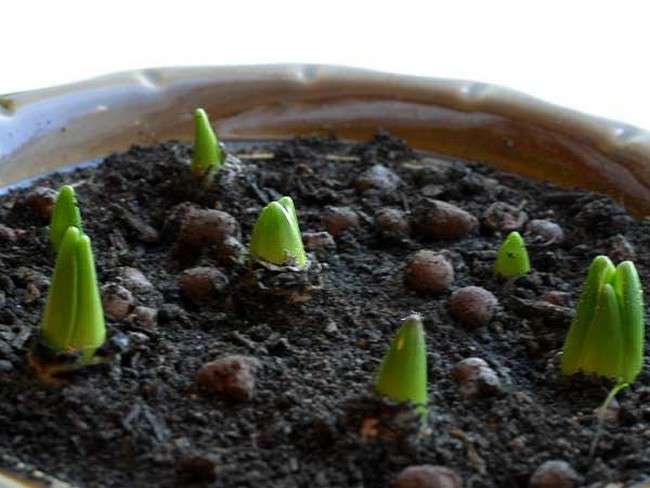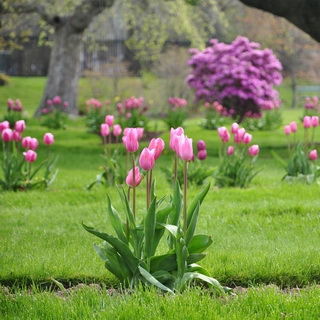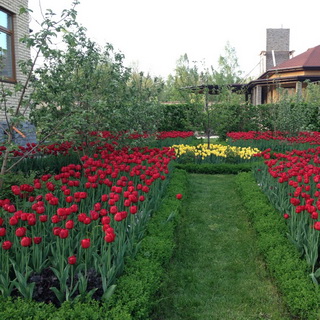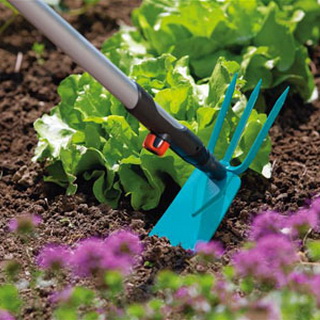Tulip variety Fantasy (Fantasy).
Tulip variety Fantasy is easy to care for and propagate, grown from bulbs or seeds. It grows up to 50-55 cm, blooms with single, large flowers. The petals, like other parrot tulips, are cut along the edges, with a decorative, wavy bend. The fabric of the petals is painted in the most delicate pinkish shade, and there are contrasting, bright green strokes in the center.
For a beautiful and long-lasting flowering, the Fantasy tulip must grow in partial shade, and receive enough moisture. The flower grows and reproduces poorly in alkaline soil, next to other bulbous spring flowers.
PARROT TULIPS IN GARDEN DESIGN
Pink tulips work well with plants with purple, brown-bronze, silvery or bluish foliage. Also in the company you can pick up white, peach or blue flowers for them.
With perennials that have yellowish green leaves, pink tulips will create an attractive contrast.
Yellow tulips contrast beautifully with blue and red flowers and harmoniously combine with white flowers and all shades of yellow: from chartreuse through apricot to golden and bronze.
Magenta purples are good when surrounded by cool shades of reds, blues and magenta or pastel lilacs, pinks, and blues. Contrast will be given by combinations with yellow, yellowish-green and orange.
Red and orange tulips warm up hot color schemes with scarlet, orange and peach flowers and contrast with whites, blues and purples. White tulips go well with all flowers. Dark purples will look even darker against lighter shades, as well as oranges, greenish yellows, and cool purples and lilacs.
Late flowering tulips
Late (from the second half of May) bloom Simple late, Lily-colored, Fringed, Green-colored, Rembrandt tulips, Parrot and Terry late tulips.
The height of their peduncles ranges from 40 to 80 cm and above. The color of the flower is varied. Tall varieties of the first five classes are used for cutting. Some varieties of the classes Simple late, Lily-colored, Fringed are well amenable to forcing. And Parrot and Terry late tulips are mainly used for flower decoration of gardens and parks.
Simple late tulips
The late ones are characterized by the goblet shape of the flower and its square base, making up 1/5 of the entire assortment.
Fringed tulips
The edge of the tulip petals from the Fringed class is decorated with a needle-like fringe that looks like hoarfrost. The color can be different, with the exception of black. Flower size and flowering time vary.

Tulip Blue Heron (Fringed Tulip Blue Heron) Peduncle height up to 50 cm. The flower is goblet, large, 7-9 cm high. The fringe is thick, long.
Green tulips
The class Green tulips unites plants, the back of the petals of which has a stable green color and, as a rule, is thickened. The color of the edges of the petals can be white, pink, red, yellow.

Spring Green tulip (Viridiflora tulip Spring Green)
Late flowering variety. The variety was bred in 1969. Peduncle 50-60 cm high, flower up to 8 cm high, glass-cup-shaped.
Rembrandt tulips
The Rembrandt tulip class includes all tulips whose variegation is genetically fixed. The flower has a goblet shape and is rather large in size. On the modern market, the class is represented by the smallest number of varieties.
Lily tulips
Lily-colored tulips have a peculiar flower structure with pointed petals bending outward.
 Tulip from the Liliacet group, the Pretty Woman variety (Beautiful Lady). Peduncle height 50-60 cm.
Tulip from the Liliacet group, the Pretty Woman variety (Beautiful Lady). Peduncle height 50-60 cm.
Parrot tulips
Parrots are distinguished by their peculiar appearance due to the cut or wavy edge of the petals. Peduncles are rather weak and bend under the weight of large, up to 20 cm in diameter, flowers.

Parrot tulip varieties Black Parrot
The flower is maroon with thin stripes of green. Flowers up to 10 cm high.
Peduncle up to 45 cm high. Blossoms at the end of May.

Tulip from the group of Porpugaynyh variety Bright Parrot (Bright Parrot).
Terry late tulips
Late double tulips have large flowers similar to those of peonies. Peduncles often break off under their weight. These tulips have not yet received wide distribution.
 Tulip Sensual Touch (Sensual Touch) belongs to the group of super-tulips "Double Effect": the variety combines several features at once: fringed and terry. Peduncle height 55 cm.
Tulip Sensual Touch (Sensual Touch) belongs to the group of super-tulips "Double Effect": the variety combines several features at once: fringed and terry. Peduncle height 55 cm.
The flower is densely double, orange-red with yellow fringes.
Storing tulip bulbs
Dug out bulbs should be disinfected from diseases and pests before drying. Rinse them in running water and soak for half an hour in a three to four percent solution of karbofos, or immerse the bulbs in hot (50 ºC) water for ten minutes. Then arrange the bulbs in a single layer in a shaded dry room with good ventilation and a temperature of 25-30 ° C and dry them there for 3-5 days before storing the tulip bulbs.
All information about hyacinths - growing from A to Z
How to store tulips before planting: clean the bulbs from old scales and roots, from the remnants of the earth, sort by size, separate the easily departing children. Scatter tulip bulbs in a single layer in trellis boxes and place them in a barn or attic. Do not cover the bulbs; they release ethylene, which can kill babies. Provide the stored bulbs with good ventilation and low ambient light.
The optimum storage temperature is 20 ºC until September, later it is advisable to lower the temperature to 17 ºC and store the bulbs at this temperature until they are planted in the open ground.
Feel and inspect the bulbs at least once a week for pests or diseases, and ruthlessly discard soft bulbs or bulbs with white or yellowish spots, as this may be a symptom of a putrid infection. Before planting in the fall, treat the tulip bulbs with a potassium permanganate solution again to avoid unpleasant surprises in the spring.
Planting bulbs

How to plant tulips at home (general instructions):
- Laying thin drainage on the bottom of the container. Material - gravel, expanded clay, ceramic fragments, small stones. Drainage is necessary for the free flow of excess water and to prevent soil leaching.
- Falling asleep
- Light irrigation of the soil with weak potassium permanganate.
- Peeling the husks from the bulb and lower root parts.
- Installing and pressing the root part into the soil so that the flat sides are turned towards the wall of the container. You cannot scroll! Observe the distance between the planting material and the container wall, as indicated above.
- Fill up the planting material with soil, holding it to prevent overturning on its side and not compacting the top layer. The sharp tops remain uncovered.
- Abundant watering of future tulips and installation in a cool room for 5-7 weeks at a temperature of + 4-6 ° C and a humidity of 70-75%. At the same time, the pot with seedlings is closed with black dense cardboard in the form of a cone, making a hole in it at the top for air exchange. The cone or newspapers will protect the planting material from the light of the light bulbs in the basement or cellar.
- Moving the pot with seedlings from a cool to a warm room for 6-7 days at a temperature of 12-14 ° C: on windows where there is no central heating, near the balcony door. Do not remove the dark cardboard cone.
- Watering the seedlings when the top layer of the earth dries up.
- Removing the shading with a cone when the sprouts reach 7-10 cm in height and placing the pot in a bright place with diffused sunlight (not direct ultraviolet light!) At an air temperature of 18-21 ° C. Better on east or west windows.
- Feeding the planting material 1-2 times together with watering when the soil dries up with a solution of calcium nitrate or complex fertilizers for plants blooming in the room.
- Transfer the container with tulips overnight to a cool place near the balcony door and return to a warm place in the morning in order to increase the flowering time.

After the end of flowering in July, you should break off the buds and gradually reduce the amount of watering until the leaves turn completely yellow, and remove the bulbs from the ground.
What features does a dwarf tulip have?
Flower features
The dwarf tulip is a wild flower that grows in Turkey, Iran, Iraq on mountain peaks and rocky slopes. The plant is listed in the Red Book. The size of the flower is very compact: the stems reach a maximum of 10 cm, and the bulbs are up to 2-3 cm in diameter. The number of leaves never exceeds 5, they almost always lie on the ground. The leaves grow in length from 4 to 11 cm, the width is no more than 1.5 cm, the edges are wavy and matte, of a bright green hue. One bulb can produce 2 flowers.
On the inner leaves, you can see a beautiful medium vein. Outside, the plant has a whitish color and a brownish-purple bloom. A distinctive feature of a dwarf tulip is its stamens - they can have different colors, shades and sizes.
The plant begins to bloom in early May to early June. When choosing a tulip variety, you need to rely on its appearance, colors and your own preferences. Sometimes you come across velvet flowers, similar to dahlias and lilies. The color scheme of the plant combines bright and delicate shades. Among the delicate shades, there are pastel white, pale pink, light lilac, and among the bright ones - crimson, purple, red, yellow, orange, cherry colors.
Tulip varieties
Of all the varieties and varieties, the most popular are the following tulip varieties:
• Lilliputian - has a red color, narrow petals, a black base and a purple throat. • Odalisque is a cherry-lilac variety with lemon throat and golden stamens. • Tet-a-Tet - double flowers of scarlet color, similar to a parrot tulip. • Persian pearl - dark lilac-pink petals with a yellow base and pointed leaves. • The East Star is a lilac-pink variety with golden brown petals and a bright yellow base. • Glow - Has a bright magenta color, yellow base and dark border.
In what conditions does a dwarf tulip grow?
To grow such a plant in rockeries, it is necessary to create the right conditions for it. A dwarf tulip needs sunlight, warmth, and protection from wind and drafts. Therefore, it is best to grow it in greenhouses. The tulip is unpretentious to the ground - it can grow both on a flat and on a rocky surface, however, water stagnation around it should not be allowed. The tulip loves drained loose soil, it excludes the possibility of stagnant water. It is best to plant the bulbs in an alpine hill.
Loam and sandstone are good soil for the plant, but other soil can also be diluted with peat, sand or fertilizers. For better absorption, it is advisable to drain the soil before planting, the drainage is placed at the bottom. The soil should contain a minimum amount of alkalis, and the pH value should not exceed 8.0.
If you are planting a tulip in a pot or container, you need to choose a specialized substrate. After planting, the flower pot must be placed in a well-lit place. Before planting in a rockery or rock garden, you will need to make holes. You can plant one tulip or a bunch of bulbs in one hole. Before planting the bulbs, they should be thoroughly etched in a solution of potassium permanganate.The bulbs need to be buried vertically into the ground, about 5-7 cm, the pits should be located at a distance of 10-15 cm.
How to care for a dwarf tulip
• after planting, you need to closely monitor the development of the plant in order to prevent various diseases; • it is necessary to regularly feed the flowers with a complex of mineral fertilizers; • be sure to water the tulip during ovary and flowering; • periodically you will need to loosen and weed the ground; • when the flower has faded, you need to remove dried flowers and dried yellow leaves.
There is no need to dig up tulips every year, it is only worth doing for the propagation of plants. Usually flowers grow in flower beds, if desired, after 3-4 years they can be dug up and divided. If you are satisfied with their number and location, you need to dig it out only after 7-8 years. After digging up the bulbs, they need to be dried, sorted and stored in a dark and cool room.
Planting and caring for tulips outdoors
How to plant tulips correctly to provide decorative plants? The bulbs are planted in the fall so that they have time to root well before frost. The best time for planting is from mid-September to mid-October, when the soil temperature at a depth of 10 cm will drop to 6-10 ° C. It is recommended to change the planting site annually, returning the tulips to their old place not earlier than after 3-4 years.


To ensure proper care of tulips in the open field, planting on ridges is done in rows or in groups. The bulbs are placed at a distance of 5-10 cm from each other, depending on their size and variety, between the rows maintain a distance of 20-25 cm. After planting, when caring for tulips, it is advisable to spill the grooves with a disinfectant solution. Planting depth of large bulbs 10-12 cm, small - 5-8 cm. In 3-4 weeks after planting tulips can be fertilized with nitrophosphate (30-40 g / m2). And when a "frosty crust" begins to form on the soil, the plantings are covered with a layer of mulch (8-10 cm), which will protect the bulbs not only from the cold, but also from sudden changes in temperature. In the spring, after the snow melts, the mulching layer should be partially removed, leaving 1-3 cm.


After emergence, the soil is loosened to open air access to the plant roots and reduce moisture evaporation. Loosening is carried out systematically - after each watering, top dressing or heavy rain. Weeds must be removed regularly.


During the growing season, tulips are fed three to four times with mineral fertilizers: in the snow, when sprouts appear, during budding, after flowering. Top dressing should be carried out with a full complex fertilizer. For top dressing, it is better to use crystallin, soluble, nitroammophos (50-60 g per 10 l of water), which are readily soluble in water. It should be remembered that an excess of nutrients is harmful: the integrity of the integumentary scales of the bulbs is violated, which increases the likelihood of their disease.
During growth, especially during budding and flowering, plants need a lot of water. Watering should be regular and abundant (at least 10 l / m2) so that moisture penetrates to the depth of the roots. When watering and feeding, moisture should not get on the leaves, as this contributes to the development of gray rot.
When cutting tulips, you need to leave one, or preferably two, leaves so as not to disrupt the formation of the bulb. The ovaries formed after flowering must be removed.
How to grow and care properly?
Despite the fact that these flowers are considered unpretentious and do not require special care, before planting, you should carefully study the recommendations of experienced gardeners.
- Landing place. Tulips should be planted in an open, sunny place, preferably calm. They thrive in light shade and can be planted next to trees and shrubs that have late leaves.
- Planting process.Bulbs of this variety are best planted in the fall, at the end of September, in light sandy or loamy soil, which must be dug deep. Soils with stagnant groundwater are not suitable for these colors. A month before planting, humus or compost is introduced into the ground (two buckets per square meter). The temperature of the earthen soil should be about +10 degrees Celsius. The bulbs are planted to a depth of 10-15 centimeters at a distance of 5-10 centimeters if the bulbs are medium-sized, and 20 centimeters if the bulbs are large. You can plant in early spring, after the snow melts, but then the tulips will bloom later and will have small buds this year.
- Watering. During the budding and flowering period, tulips are watered abundantly and regularly in the early morning or evening. The water should be settled and not cold. In this case, it is necessary to avoid splashing water on the leaves. After each watering, the soil near the plant should be loosened so that air can flow to the roots, and the moisture does not evaporate too quickly.
- Top dressing. During the growing season, it is recommended to apply mineral fertilizers several times: in early spring, with the formation of buds and after the end of flowering. You cannot use fertilizers with a large amount of chlorine: it damages the roots of these flowers. If you have already applied organic fertilizers to the soil, then the amount of mineral fertilizing should be minimal.
- Reproduction. In order for the plant to form full-fledged bulbs, after flowering, the seed heads should be removed. These flowers are easy to propagate with bulbous babies, which are easily separated from the mother's bulb when excavated. It is advisable to dig up varietal tulips every year so that the flowers remain as large. Removing the bulbs can begin after the leaves turn yellow and the bulb scales turn brown (around the end of June).
- Storage. After digging the bulbs, it is recommended to dry for 7-10 days at a temperature of about + 21-25 degrees Celsius, then they should be separated from each other and sorted by size. Next, you need to remove the earth, dead roots, old scales. Sick and damaged bulbs must be destroyed. Bulbs should be stored at a temperature of + 20-23 degrees Celsius, out of sunlight, in well-ventilated sheds or attics until the end of August. Then the bulbs are kept at + 15-17 degrees before planting in the soil, it is advisable to treat them with fungicides to prevent the occurrence of diseases.
- Wintering in the soil. If you decide to leave the tulips for the winter, but are not sure that there will be enough snow cover, mulch with peat, sawdust, straw, compost. The height of the shelter should be between 6 and 14 centimeters. Mulch should be done only after stable soil freezing.
Tulips are adorable spring flowers that you can't help but admire. Dynasty flowers are especially delicate and exquisite. Plant them in your garden so that they bloom brightly every spring and give you a lot of positive emotions.
How to transplant tulips is described in the next video.
Tulip Dynasty - this perennial bulbous herb will be a chic decoration for any flower bed or a beautiful festive bouquet.
Due to its high goblet peduncle and a fairly strong stem, this tulip has unique decorative qualities.


